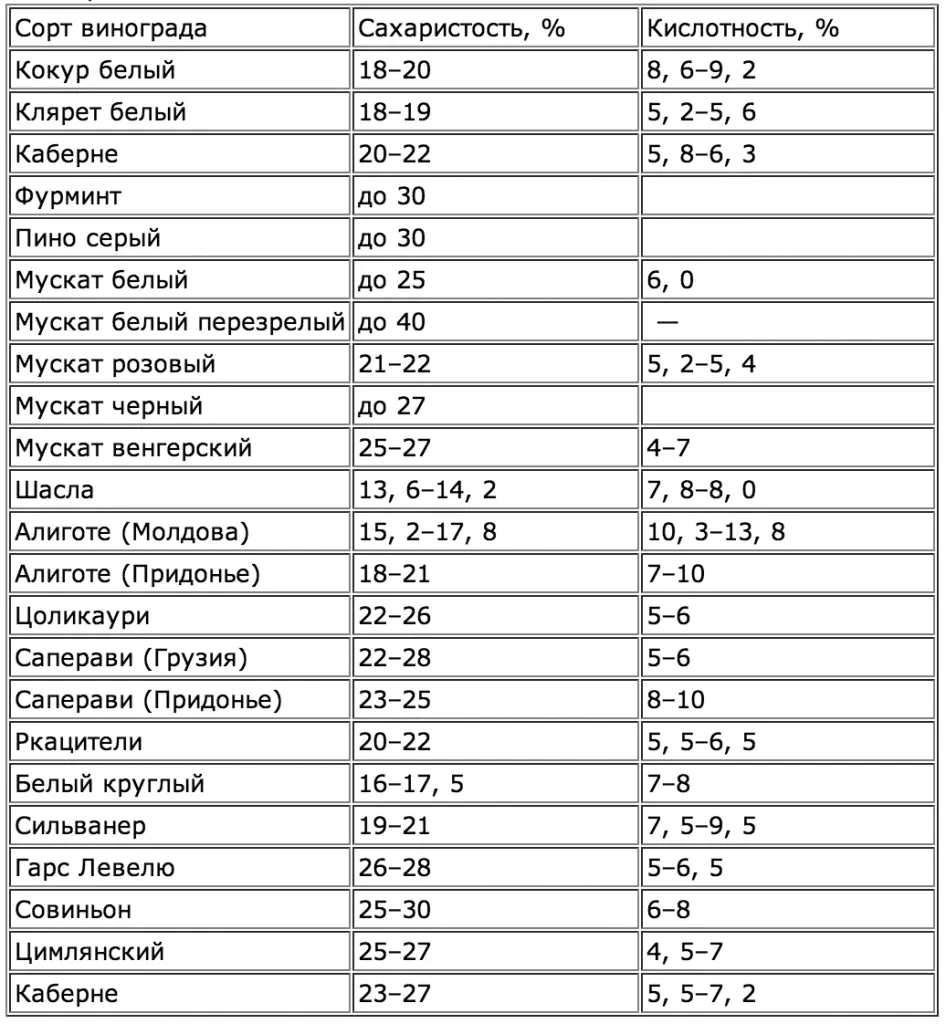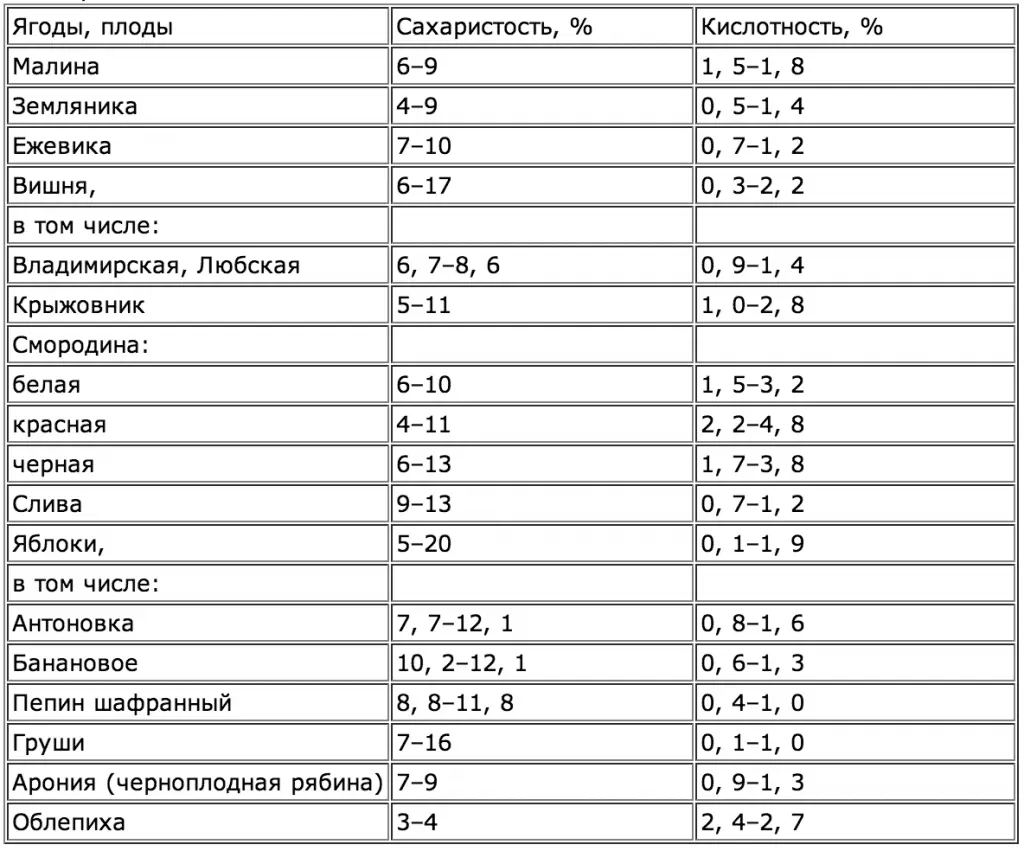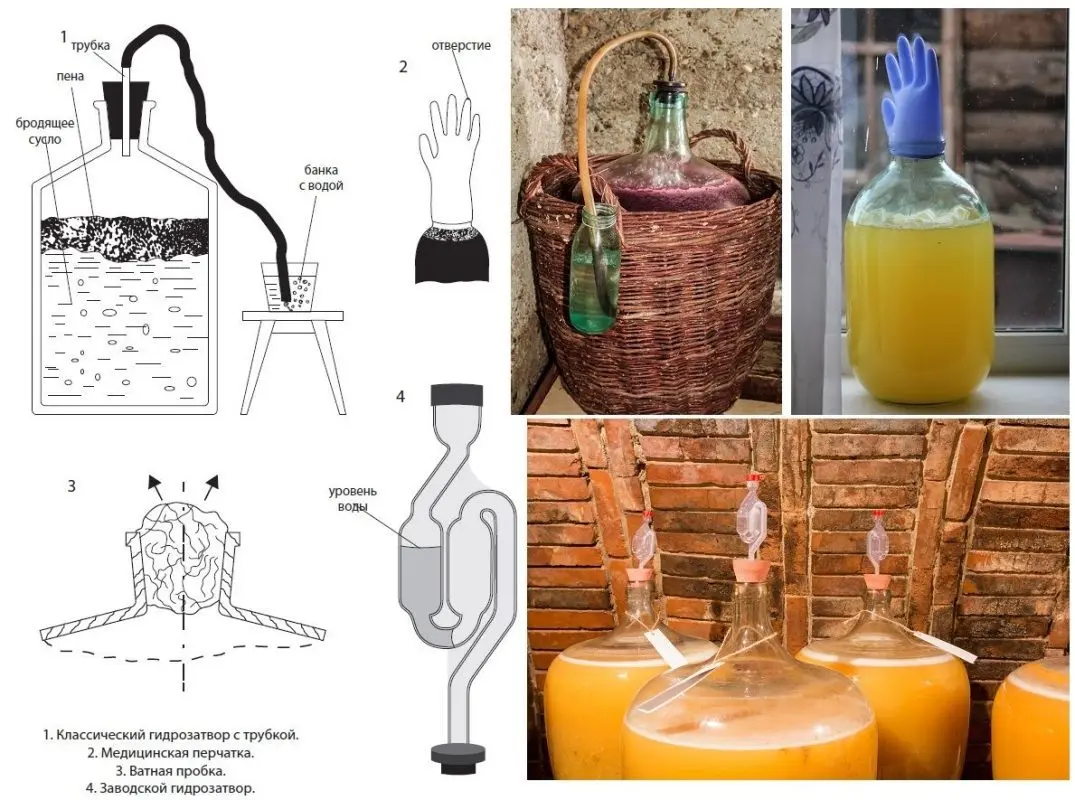Contents
In home winemaking, the most heated debate concerns whether or not to add water to wine. Proponents of this method argue that after proper dilution, the wine is not as sour, and the drink itself is larger. Opponents remind that the addition of water worsens the taste and reduces the shelf life. In fact, it all depends on the initial characteristics of the juice.
Theory
The optimal titratable (total) acidity of the finished wine is 4-6 grams of acid per 1 liter. This refers to the total value of all basic acids (citric, succinic, malic, lactic) and their salts. During fermentation, the concentration of these substances decreases, therefore, depending on individual taste preferences, the initial acidity of the juice may be higher – 6-15 grams per liter.
The problem is that at home it will not be possible to accurately determine the concentration of acid in the juice; this requires laboratory equipment and reagents. Approximate values can be found by referring to the tables.


It is important to take into account that the acidity of the same raw material depends on the type of soil, climate, weather (precipitation and sunny days) and even in one region it can be different from year to year.
To more accurately determine the acidity of wine with improvised means, use the pH indicator (potentia hydrogeni, takes values from 0 to 14) – the negative logarithm of the effective concentration of hydrogen ion activity. A special device is required – a pH meter, household models of which can be found on the Internet. The lower the value, the higher the acidity of the solution: 0 – strong acid, 14 – alkali.
The active acidity of the must before fermentation of the wine should be in the range of 2,8 to 4 pH.
Titrated (total) and active acidity are interconnected (a decrease in one leads to a decrease in the other and vice versa), but it is impossible to find a numerical relationship in the form of proportions or formulas. This means that, knowing the pH of the juice, it will not work to determine the acid content in grams per liter.
When to add water to wine
Dilution of the juice with water is advisable only to reduce the acidity to the recommended value. Another option is possible – for one reason or another, the sugar content of the wort is above 20%, as a result of which the fermentation stopped, but then it is better to lower the sugar concentration with a new batch of pure juice, and not with water.
The more water added to the wort, the lower the solids content in the finished wine will be, which will negatively affect the taste of the drink, as they say: the wine turned out to be watery.
Often the problem of reducing the acidity of the juice is faced by residents of non-wine-growing regions or if there were few sunny days in the season (typical for grapes, apples, plums and cherries). For example, grapes grown in central Russia or in the north have a much higher acidity than the same variety from the southern regions. If you do not add water, the wine will turn out to be very sour, with a burning taste, sometimes the acid even crystallizes on the walls of the vessel with the drink.
Attention! Water should be added to the wine immediately before or during the first 10-15 days after the start of fermentation. The introduction of water during maturation or storage leads to spoilage of the drink, so diluted wine must be drunk immediately, re-fermented or stabilized with alcohol, increasing the strength to 12-16%.
How much water to add to wine
First you need to determine the initial acidity and sugar content of the juice. There are 3 methods:
- Using a pH meter and wine meter. The best option. To find out the desired indicators, it is enough to alternately lower both devices into a container with wort.
- By tables. An approximate method, since the values uXNUMXbuXNUMXbdepend not only on the type of raw material and variety, but also on the climate in the region and the weather of the year.
- Taste. The most inaccurate method, since each person’s taste sensations are subjective. Water is required only if the juice is so sour that it stings the tongue and tightens the cheekbones. Residents of the northern regions can play it safe by adding 10-15% of water from the volume of juice.
Relationship between acidity, water and sugar
It should be borne in mind that not only water, but also sugar reduces acidity, while it is correct to calculate by volume, and not by mass: 1 kg of dissolved sugar occupies 0,6 liters of volume, reducing the acid content in the wort by 60%. In turn, the addition of water reduces the acidity by 2 times.
1% fermented sugar gives 0,6% strength, therefore, to obtain wine with an alcohol content of 12%, 200 grams of sugar per 1 liter (natural in juice and added) is required. If the wine is not dry, but semi-sweet or sweet, then when determining the acidity, the sugar introduced after fermentation must also be taken into account.
First, the acidity is reduced by the amount of sugar that is planned to be added. Only after that determine the right amount of water. An example of the calculation will be in the recipe, you can also use the calculator and determine the desired values for dry wine.
Counting in progress…
Enter the initial data on the left
Recipe for wine with water
The task is to make a semi-sweet grape wine with a strength of 12%, a sugar content of 5% and reduce the acidity of the must to 6 grams / liter. At the same time, there are 5 liters of fresh juice with an initial acidity of 18 grams and a sugar content of 8% per 1 liter.
When calculating according to tables:
- Total wort volume increase (O) = (initial acidity / required acidity) = 18 / 6 = 3 (times);
- Proportions of water and sugar by volume (VS) u1d O – 2 uXNUMXd XNUMX (times);
- Must sugar percentage (Sax) = sugar to achieve desired strength (desired strength percentage / 0.6) + residual sugar for sweetness = 12 / 0.6 + 5 = 25%.
- Amount of sugar (K) = (O * amount of juice * Sax) – (initial sugar content of juice (kg) * amount of juice) = (3 * 5 * 0.25) – (0.08 * 5) = 3.35 kg;
- Volume occupied by sugar (S) = K * 0.6 = 3.35 * 0.6 = 2.01 liters;
- Required amount of water (VOD) = VS * amount of juice – S = 2 * 5 – 2.01 = 7.99 liters.
- Total volume of wort (V) = amount of juice * O = 3 * 5 = 15 liters.
- Sugar for sweetening the finished wine (SS) = V * sugar for sweetness (%) / 100 = 0.75 kg;
- Sugar to be added at the fermentation stage (Vb) = K – SS = 3.35 – 0.75 = 2.6 kg.
Using the same algorithm, you can determine the amount of water for any other sour juice: apple, cherry, etc.
When calculating with a pH meter, the sugar content in the wort is first adjusted to about 20% hydrometer, then water is added in small batches to a value of 2,8-4 pH. At the fermentation stage, the sugar content and strength are controlled by a wine meter. Adjustments are made based on the relationship between acidity, sugar and water (juice), which is described above.
To increase the acidity of the must (required in the case of sweet raw materials such as peaches or apricots, as well as when diluted too much with water), you can use pure citric acid in bags or squeeze fresh lemon (the juice of one medium-sized fruit contains 5-6 grams of acid).
Ingredients:
- grape juice – 5 liters;
- sugar – 3,35 kg;
- water – 7,99 l.
Wine making technology
1. Unwashed (so that wild yeast remains on the skin), crush the grapes and leave for 3-4 days in a dark room at room temperature in a plastic or enameled container (pot, barrel or bucket) with a wide neck. Add wine yeast if desired. Cover the container with gauze from flies.
Every 8-12 hours, stir with a wooden stick or a clean hand, drowning in the juice the surfaced pulp – peel and pulp. After 8-20 hours from the start of cooking, foam, hissing and a slight smell of fermentation should appear, which means that everything is going fine.
2. Filter the fermented juice from the pulp through gauze or a sieve, squeeze the cake well. Add all the water and a third of the sugar (0,87 kg according to the recipe in the example). Mix.
Attention! During fermentation, I advise you to add sugar at intervals of 4-5 days in three equal portions in a total amount of not more than 200 grams per 1 liter of diluted juice, taking into account the natural sugar content of raw materials. Then, after the end of fermentation, sweeten the drink to taste.
3. Pour the wort into the fermentation tank, filling it to a maximum of 75% of the volume to leave room for the next portions of sugar, foam and carbon dioxide. Install a water seal of any design (you can get by with a glove with a hole in your finger). Transfer the future wine to a dark place (cover with a thick cloth) with a stable temperature of 18-28°C.

4. 4-5 days after the installation of the water seal, drain 50% of the wort from one serving of sugar into a separate container (approximately 450 ml according to the example). Dilute sugar (0,87 kg). Pour the resulting syrup back into the container with wine and close the water seal. After 4-5 days, repeat the procedure for adding sugar using the same technology, adding the last portion (0,87 kg).
5. Depending on the yeast, temperature and sugar content of the juice, the duration of the fermentation of homemade wine is 25-60 days. If the process lasts longer than 45 days, in order to avoid the appearance of bitterness in the taste, the drink must be poured through a tube into another container without touching the sediment, and put under a water seal.
After fermentation is over (the water seal does not release gas for a couple of days or the glove is blown off), remove the young homemade wine from the sediment by pouring it into another container through a straw (it is important not to touch the loose layer of pulp at the bottom).
6. Try a drink. Add sugar to taste (0,75 kg according to calculations), adjusting the sweetness. You can also fix with alcohol or vodka (2-15% by volume).
Pour the wine into aging containers (preferably filled to the top to avoid contact with oxygen). Transfer to a refrigerator or cellar with a temperature of 5-16°C for maturation. Leave for at least 40 days (optimally 60-120 days).
7. Periodically, when a sediment layer of 2-5 cm appears, filter by pouring through a tube (siphon).
8. When sediment no longer appears, the finished drink can be bottled for storage and hermetically sealed.

The shelf life of homemade wine with the addition of water is up to 3 years (on pure juice – 5 years or more) if stored in a refrigerator or cellar (cellar). Fortress – 10-14%.









